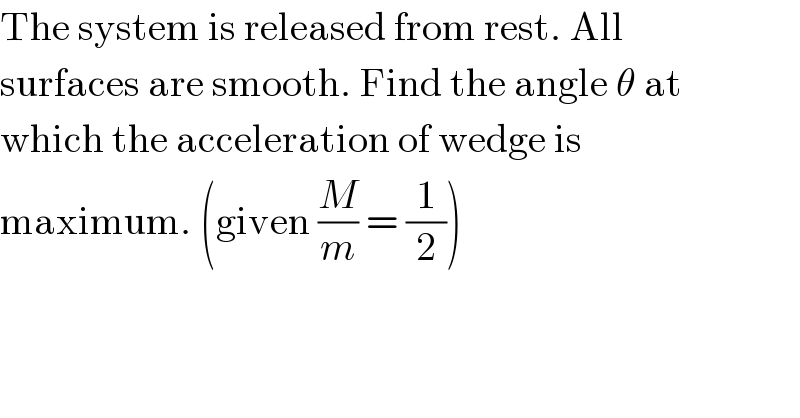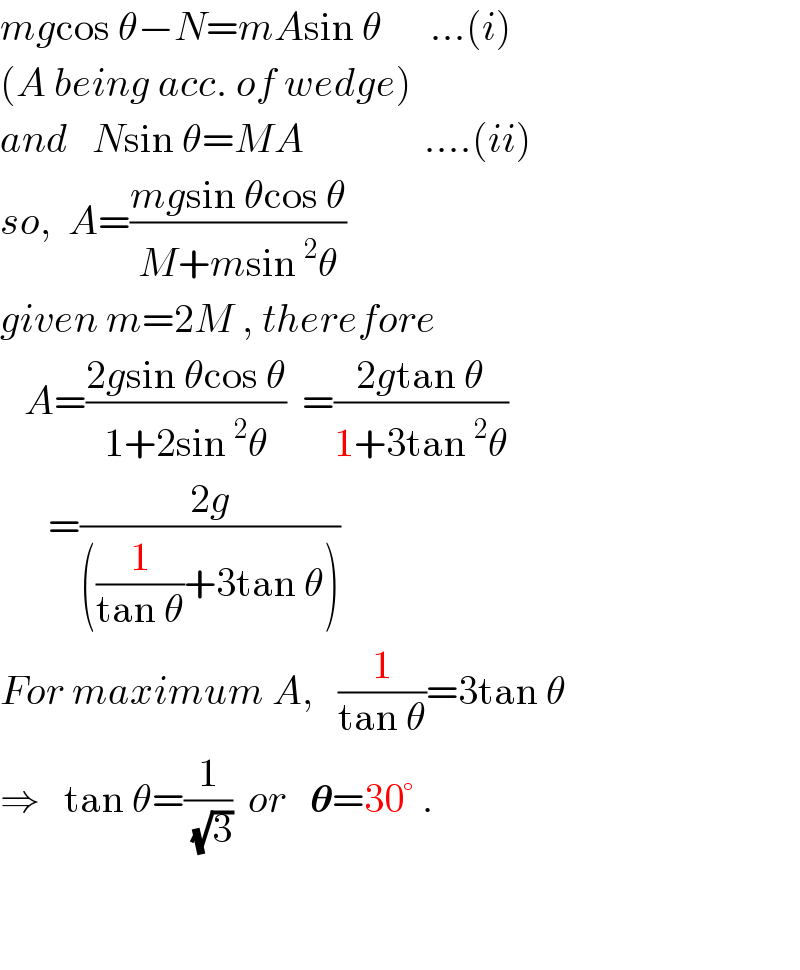
Question Number 23617 by Tinkutara last updated on 02/Nov/17

$$\mathrm{The}\:\mathrm{system}\:\mathrm{is}\:\mathrm{released}\:\mathrm{from}\:\mathrm{rest}.\:\mathrm{All} \\ $$$$\mathrm{surfaces}\:\mathrm{are}\:\mathrm{smooth}.\:\mathrm{Find}\:\mathrm{the}\:\mathrm{angle}\:\theta\:\mathrm{at} \\ $$$$\mathrm{which}\:\mathrm{the}\:\mathrm{acceleration}\:\mathrm{of}\:\mathrm{wedge}\:\mathrm{is} \\ $$$$\mathrm{maximum}.\:\left(\mathrm{given}\:\frac{{M}}{{m}}\:=\:\frac{\mathrm{1}}{\mathrm{2}}\right) \\ $$
Commented by Tinkutara last updated on 02/Nov/17

Commented by ajfour last updated on 02/Nov/17

$${mg}\mathrm{cos}\:\theta−{N}={mA}\mathrm{sin}\:\theta\:\:\:\:\:\:...\left({i}\right) \\ $$$$\left({A}\:{being}\:{acc}.\:{of}\:{wedge}\right) \\ $$$${and}\:\:\:{N}\mathrm{sin}\:\theta={MA}\:\:\:\:\:\:\:\:\:\:\:\:\:\:\:....\left({ii}\right) \\ $$$${so},\:\:{A}=\frac{{mg}\mathrm{sin}\:\theta\mathrm{cos}\:\theta}{{M}+{m}\mathrm{sin}\:^{\mathrm{2}} \theta} \\ $$$${given}\:{m}=\mathrm{2}{M}\:,\:{therefore} \\ $$$$\:\:\:{A}=\frac{\mathrm{2}{g}\mathrm{sin}\:\theta\mathrm{cos}\:\theta}{\mathrm{1}+\mathrm{2sin}\:^{\mathrm{2}} \theta}\:\:=\frac{\mathrm{2}{g}\mathrm{tan}\:\theta}{\mathrm{1}+\mathrm{3tan}\:^{\mathrm{2}} \theta} \\ $$$$\:\:\:\:\:\:=\frac{\mathrm{2}{g}}{\left(\frac{\mathrm{1}}{\mathrm{tan}\:\theta}+\mathrm{3tan}\:\theta\right)} \\ $$$${For}\:{maximum}\:{A},\:\:\:\frac{\mathrm{1}}{\mathrm{tan}\:\theta}=\mathrm{3tan}\:\theta \\ $$$$\Rightarrow\:\:\:\mathrm{tan}\:\theta=\frac{\mathrm{1}}{\sqrt{\mathrm{3}}}\:\:{or}\:\:\:\boldsymbol{\theta}=\mathrm{30}°\:. \\ $$$$ \\ $$$$ \\ $$
Commented by Tinkutara last updated on 03/Nov/17

$$\mathrm{Thank}\:\mathrm{you}\:\mathrm{very}\:\mathrm{much}\:\mathrm{Sir}! \\ $$
Answered by Tinkutara last updated on 03/Nov/17

Commented by Tinkutara last updated on 03/Nov/17

Commented by Tinkutara last updated on 03/Nov/17

Commented by Physics lover last updated on 03/Nov/17
![How did Mr Ajfour find the minimum value of that trigonometric equation.? [Cot θ + 3 tan θ]](Q23658.png)
$${How}\:{did}\:{Mr}\:{Ajfour}\:{find}\:{the} \\ $$$${minimum}\:{value}\:{of}\:{that}\:{trigonometric} \\ $$$${equation}.? \\ $$$$\left[{Cot}\:\theta\:+\:\mathrm{3}\:{tan}\:\theta\right] \\ $$
Answered by Physics lover last updated on 02/Nov/17
![What about this one : a_(wedge ) = (((mg×Sin θ × Cos θ))/(M+m)) as there is no force in horizontal direction ⇒ horizontal acceleratuon of the com of system should be zero.And we can use the above formula. [a_(wedge) ]_(max ) ⇒[ Sin θ Cos θ ]_(max) ⇒ θ = 45° ???? what is wrong in this one ?](Q23630.png)
$${What}\:{about}\:{this}\:{one}\:: \\ $$$${a}_{{wedge}\:} =\:\frac{\left({mg}×{Sin}\:\theta\:×\:{Cos}\:\theta\right)}{{M}+{m}}\: \\ $$$${as}\:{there}\:{is}\:{no}\:{force}\:{in}\:{horizontal} \\ $$$${direction}\:\Rightarrow\:{horizontal}\:{acceleratuon} \\ $$$${of}\:{the}\:{com}\:{of}\:{system}\:{should}\:{be} \\ $$$${zero}.{And}\:{we}\:{can}\:{use}\:{the}\:{above} \\ $$$${formula}. \\ $$$$\:\left[{a}_{{wedge}} \right]_{{max}\:} \Rightarrow\left[\:{Sin}\:\theta\:{Cos}\:\theta\:\right]_{{max}} \\ $$$$\:\Rightarrow\:\theta\:=\:\mathrm{45}°\: \\ $$$$???? \\ $$$${what}\:{is}\:{wrong}\:{in}\:{this}\:{one}\:? \\ $$
Commented by ajfour last updated on 02/Nov/17

$${how}\:{mg}\mathrm{sin}\:\theta\mathrm{cos}\:\theta\:? \\ $$
Commented by ajfour last updated on 02/Nov/17

$${what}\:{would}\:{you}\:{say}\:{for}\:{acc}. \\ $$$${of}\:{block},\:{what}\:{is}\:{it},\:{at}\:{what} \\ $$$${angle}\:{with}\:{horizontal}? \\ $$$${acc}.\:{of}\:{block}\:{is}\:{not}\:{mg}\mathrm{sin}\:\theta\: \\ $$$${down}\:{the}\:{incline}\:{direction} \\ $$$${from}\:{ground},\:\:{if}\:{observer}\:{observes} \\ $$$${motion}\:{of}\:{block}\:{and}\:{wedge}\:, \\ $$$${both}\:{from}\:{ground}\:{frame}. \\ $$
